NGC 7331 & Friends
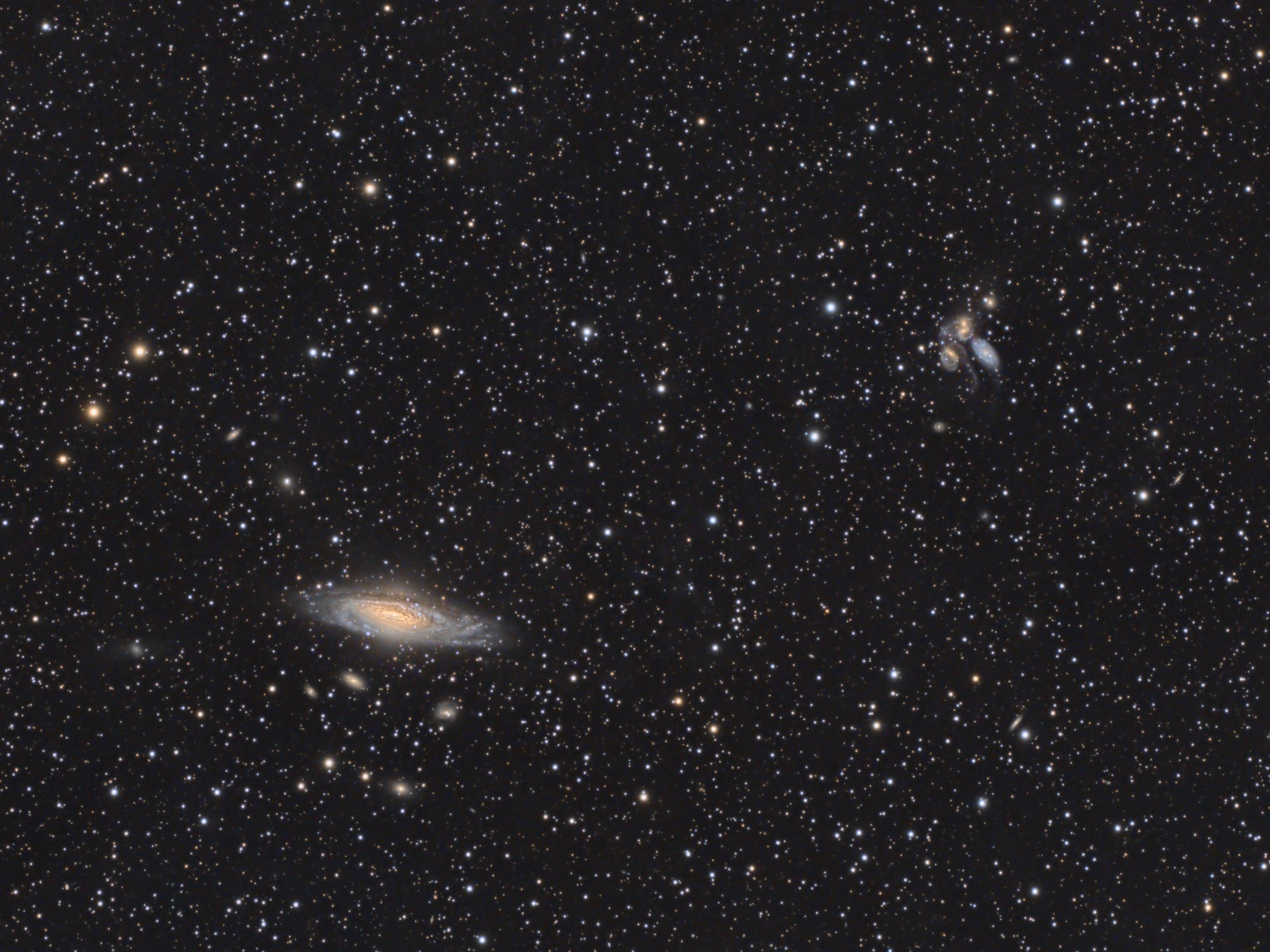 Click image for full size version
Click image for full size version
December 2, 2021
NGC 7331 is the big galaxy to the lower left of this image. NGC 7331 is in Pegasus, and is about 50 million light years away. It is the biggest member of the “Deer Lick Group”, several other members of which are obvious around (mostly beneath) NGC 7331. These galaxies are about 10 times further away, or 500 million light years (yes, half a billion light years!). See the annotated image which identifies most of the galaxies.
To the upper right of NGC 7331 in this photo is a group of galaxies called Stephan’s Quintet. Four of the five form an association about 290 million light years away, while the 5th one (the one that looks the bluest in this photo) is much closer, at “only” 40 million light years. A beautiful tidal tail visible that looks like a little curl hanging off the bottom of the quintet. I’ve seen Stephan’s Quintet several times visually through my 20″ telescope, but this image shows much more detail than I can see, and also shows colour.
Tekkies:
Acquisition, focusing, and control of Paramount MX mount with N.I.N.A., TheSkyX and PHD2. Focus with Optec DirectSync motor and controller. Equipment control with PrimaLuce Labs Eagle 4 Pro computer. All pre-processing and processing in PixInsight. Acquired from my SkyShed in Guelph. Above-average transparency and seeing. Data acquired October 1 – November 6, 2021 in a nearly moonless sky.
Luminance: Sky-Watcher Esprit 150 f/7 refractor and QHY600M camera with Optolong UV/IR filter
Chrominance: Takahashi FSQ-106 ED IV @ f/5 and QHY367C Pro one-shot colour camera with Optolong UV/IR filter
124 x 5m OSC = 10hr20m
Total: 19hr50m
Data Reduction and Initial Processing
Preprocessing: The WeightedBatchPreProcessing script was used to create a Luminance master frame from the mono camera and an RGB master frame from the one-shot colour camera. DrizzleIntegration (2x CFA Drizzle) was applied to the RGB set. The RGB master was registered to the cropped and rotated Luminance master using StarAlignment.
Gradient Removal: DBE was applied to both masters using Subtraction.
Colour
Colour Balancing: Colour was balanced with PhotometricColorCalibration.
Linear Noise Reduction: MultiscaleLinearTransform was used to reduce noise in the background areas, using an internal mask to protect bright structures. Layer settings for threshold and strength: Layer 1: 5.0 0.95, 2 iterations; Layer 2: 4.0, 0.85, 2 iterations, Layer 3: 3.5 0.75, 1 iteration; Layer 4: 2.0, 0.5, 1 iteration.
Stretching: HistogramTransformation was applied to make a pleasing, bright image, with background set to an intensity of approximately 0.10.
Lightness
Deconvolution: A star mask was made from the Luminance master to use as a Local Deringing Support Image. A stretched copy of the Luminance master was used as a deconvolution mask. . Deconvolution was applied (30 iterations, regularized Richardson-Lucy, ParametricPSF mode with default settings; Global dark deringing = 0.03; Global bright deringing 0.005).
Linear Noise Reduction: MultiscaleLinearTransform was used to reduce noise in the background areas, using an internal mask to protect bright stars and the brighter regions of the galaxy. Layer settings for threshold and strength: Layer 1: 5.0 0.85, 1 iteration; Layer 2: 4.0, 0.75, 1 iteration, Layer 3: 3.3 0.65, 1 iteration; Layer 4: 1.0, 0.35, 1 iteration.
Stretching: HistogramTransformation was applied to make a pleasing, bright image, with background set to an intensity of approximately 0.10.
Combining Lightness and Colour Images
LRGB Combination: The lightness image was applied to the RGB image using LRGBCombination with default settings.
Additional Processing
Nonlinear Noise Reduction: TGVDenoise was used in L*a*b* mode to reduce noise with the image selected as the Local Support image (used like an external mask would be, to target the background areas and protect the stars and galaxy) (max. 1,000 iterations and convergence selected for both lightness and chrominance).
Contrast Enhancement: HDRMultiscaleTransform was applied at a scale of 5 pixels through a mask that selected just the core of NGC 7331. Brightness was boosted slightly with Curves through the same mask. LocalHistogramEqualization was applied three times using an inverted star mask to protect the stars, with scales of 20, 40 and 150 (max contrast 1.5, strength 0.2, 1 iteration).
Sharpening: MultiscaleMedianTransform was used to sharpen Layers 2 and 3 with strengths of 0.2, 0.08, and 0.04, respectively, through a mask. The mask was made by subtracting the star mask from the deconvolution mask (made previously). This limited sharpening to a few specific regions of the image.
Final Steps: Background, nebula and star brightness, contrast, and colour saturation were adjusted in several iterations using CurvesTransformation with masks as required. The DarkStructureEnhance script was applied (default settings except strength = 0.2). ICCProfileTransformation (sRGB IEC61966-2.1; Relative Colorimetric with black point compensation) was applied prior to saving in jpg format.


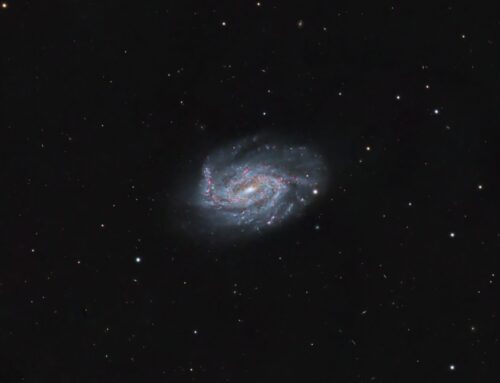
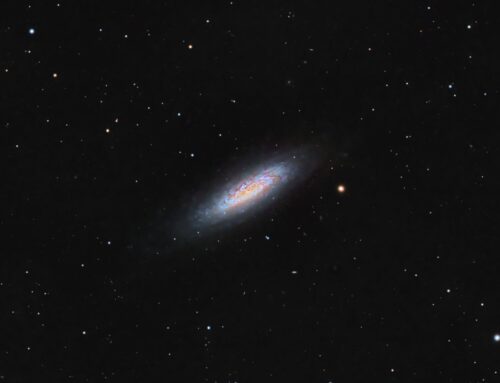
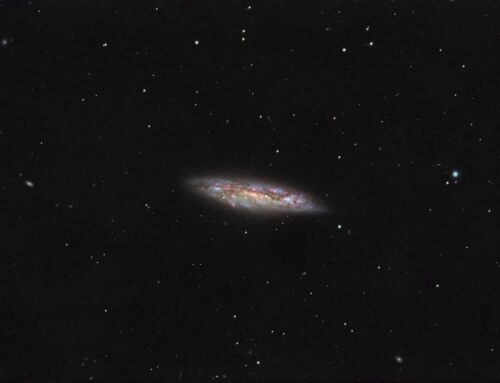
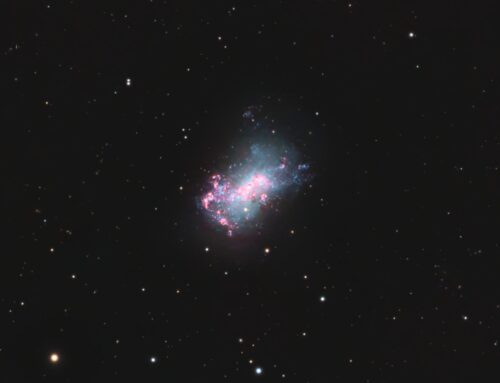
Wonderful colour and detail, a favorite area of the sky for me, nicely done.
Simply beautiful
That is amazing Ron, to be able to capture objects 500 million light years away. I have view the quintet in my 16″. I always enjoy you expert images. Thanks
Thank you for sharing the unknown. It always sparks my curiosity.
Absolutely GORGEOUS, as always!